
Assignment 12 - Fibonacci Investigation
Faith Hoyt

What exactly is the Fibonacci Number?
The Fibonacci number originally came about when Fibonacci decided to study the mating patterns of rabbits. "Suppose a newly-born pair of rabbits, one male, one female, are put in a field. Rabbits are able to mate at the age of one month so that at the end of its second month a female can produce another pair of rabbits. Suppose that our rabbits never die and that the female always produces one new pair (one male, one female) every month from the second month on. The puzzle that Fibonacci posed was...
"How many pairs will there be in one year?" (taken from http://www.mcs.surrey.ac.uk/Personal/R.Knott/Fibonacci/fibnat.html#Rabbits).
He found that at the end of the first month there is still only one pair. After the second month, the female produces another pair leaving us with two pairs of rabbits. After the third month, the original female produces another pair giving us a total of three pairs of rabbits. After our fourth month the original female produces another pair and the female that was born two months ago produces a pair so we are left with five total pairs of rabbits. This pattern continues giving us the Fibonacci sequence: 1, 1, 2, 3, 5, 8, 13, 21, 34, 55, 89, ...
Given that we know what the Fibonacci sequence is, we can now do some investigations using Excel spreadsheets.
First we want to construct the ratio of each pair of adjacent terms of our sequence. We will start with the sequence listed above beginning with 1. We can better write this as f (0) = 1 and f (1) = 1.
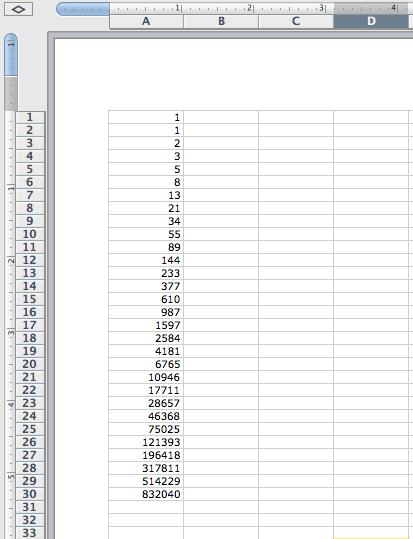
As we can see, these numbers match up to our previous list. We can generalize each of these cells using the following:
We know f (0) = 1 and f (1) = 1. By looking at the chart above, we can see that f (2) = 2, f (3) = 3, f (4) = 5, f (5) = 8 and so on.
Now to figure out what our f (n) will equal.
Well, we already said that the next term is the sum of the previous two. In other words, f (2) = f (1) + f (0) = 1 + 1 = 2. Let's look at one more just to make sure this works: f(5) = f(4) + f(3) = 5 + 3 = 8. It works! So we can generalize this for f(n) = f(n-1) + f(n-2).
Now, let's look at some ratios. First, let's construct the ratio of each pair of adjacent terms in our excel spreadsheet.
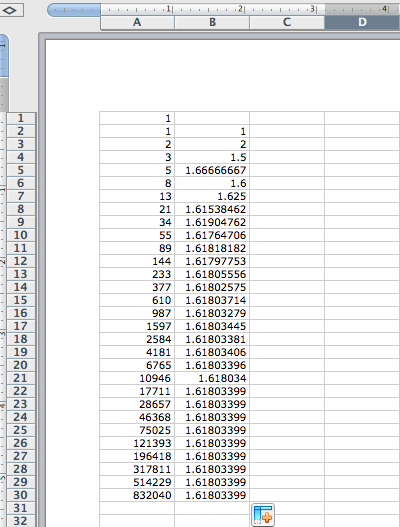
When we hear the word ratio, we should automatically think division! So what are we doing here?! Dividing! We want to find the ratio of the two adjacent terms. In our case it will be the two terms that are adjacent vertically. So, we will let r denote our first ratios as follows:
r(0) = 1/1
r(1) = 2/1
r(2) = 3/2
r(3) = 5/3
Now to generalize:

We can see that these ratios do in fact occur in the second column of our above spreadsheet. However, if we look at this second column as compared to our first column, as n increases, these numbers seem to be converging to the same number after about row 21 which is 1.6180339. But why does this happen? and Is this a significant number?
Yes!! It's actually the golden ratio! Let's prove it!
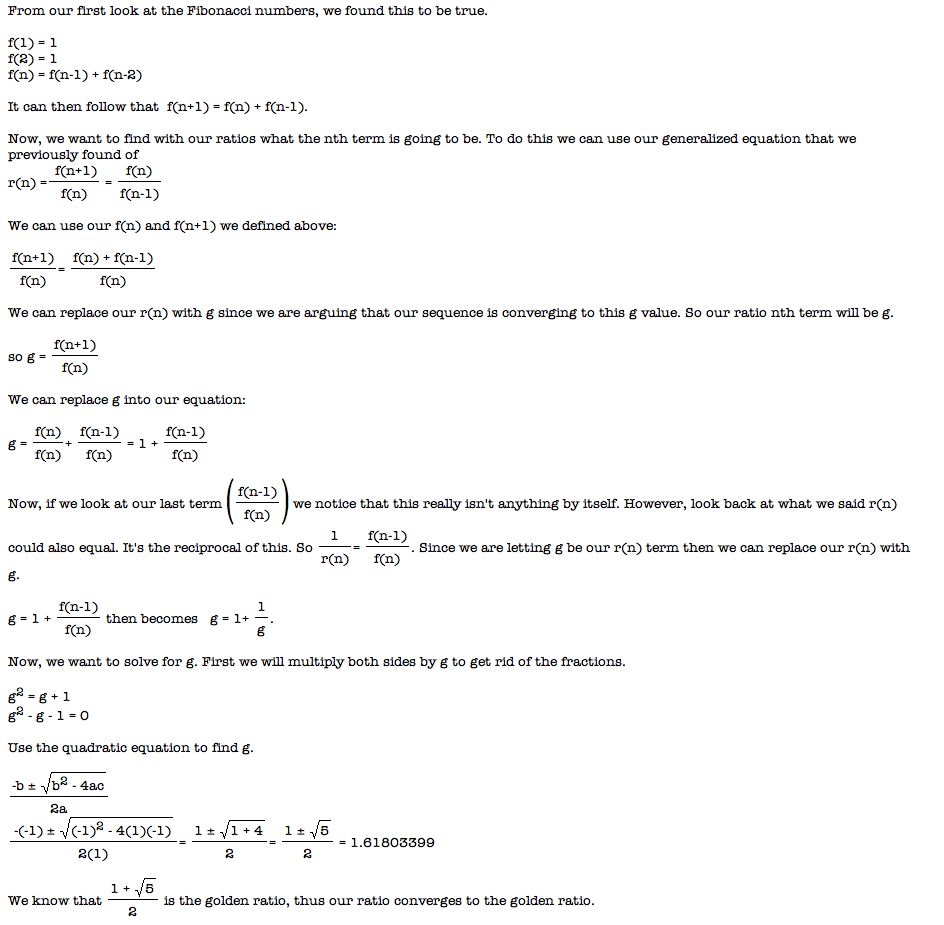
Now that we know that the ratio of two adjacent terms will converge to the golden ratio, what happens when we find the ratio of every second term?
Let's first look and see what it looks like in our spread sheet:
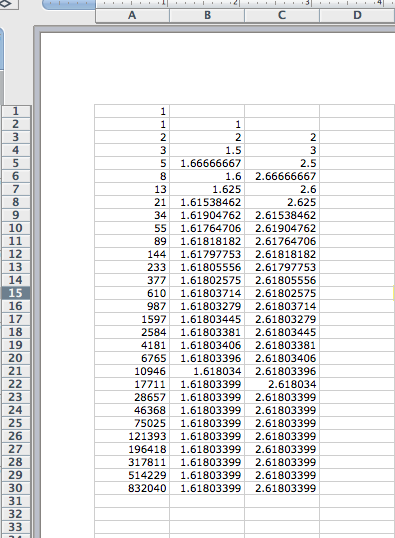
In this case we will let s represent our ratio.
s(0) = 2/1
s(1) = 3/1
s(2) = 5/2
We can generalize this for the nth term as follows:

We can see from the spreadsheet above that now as n increases, our numbers converge to 2.61803399. Looking at this number we can see that this is actually our golden ratio plus 1. Let's prove that this is the case!
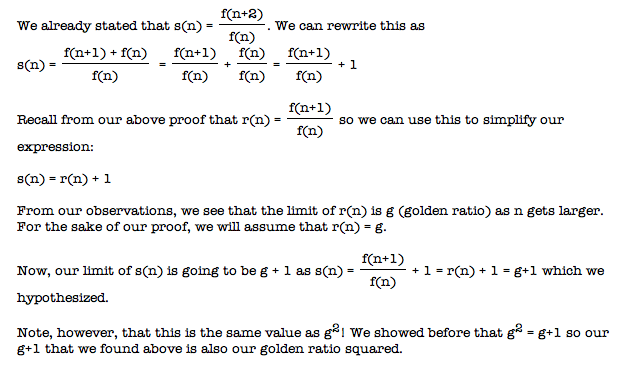
Now that we know that the ratio of every second term will converge to the golden ratio plus one, or the golden ratio squared, what happens when we find the ratio of every third term?
Let's first look and see what it looks like in our spread sheet:
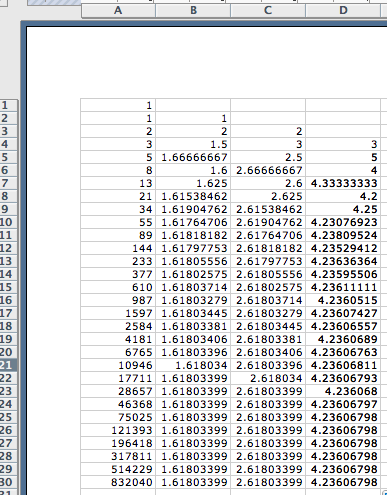
In this case we will let t represent our ratio:
t(0) = 3/1
t(1) = 5/1
t(2) = 8/2
Now, we can generalize this for the nth term by the following

Now, we notice again that as n gets bigger our numbers seem to converge to 4.23606798. What is this number and how does it relate to our other ratios? Does this number have something to do with the golden ratio? Let's see a proof!
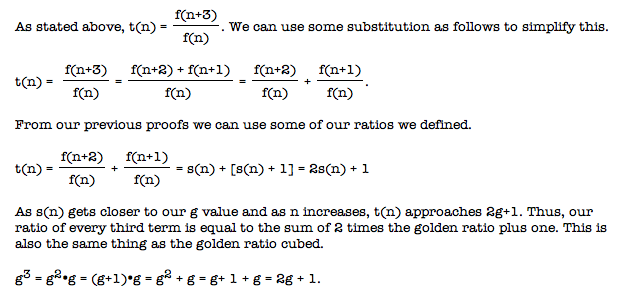
In conclusion we have seen that with each ratio we do, it in some way is related to the golden ratio. With the sum of each adjacent term, as n increases the numbers converge to the golden ratio. With the ratio of every second term, as n increases the numbers converge to the golden ratio squared. For the ratio of every third term, as n increases the numbers converge to the golden ratio cubed. What happens with the sum for the ratio of every fourth term?I'll leave that to you to discover. However, we can generalize.
Now, we want to explore the sequences where f(0) and f(1) are some arbitrary integers besides 1. If f(0) = 1 and f(1) = 3, this sequence formed will be the Lucas Sequence.
Let's look at it in the spreadsheet.

Notice that as n increases, our numbers converge to the same numbers of the fibonacci sequence!
What if we do f(0) = 1 and f(1) = 4?
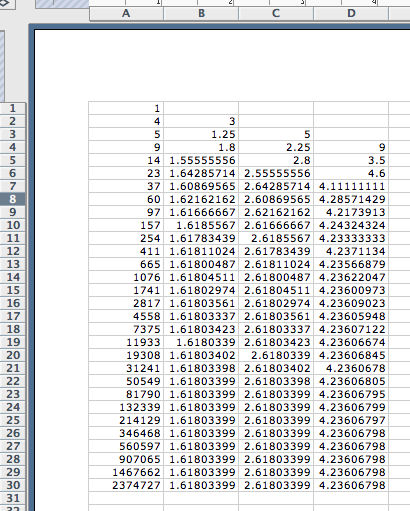
Notice that all the numbers converge to the same numbers as above, or various powers of the golden ratio.
What if our first number is larger than our second number?
Let's let f(0) = 2 and f(1)=1.
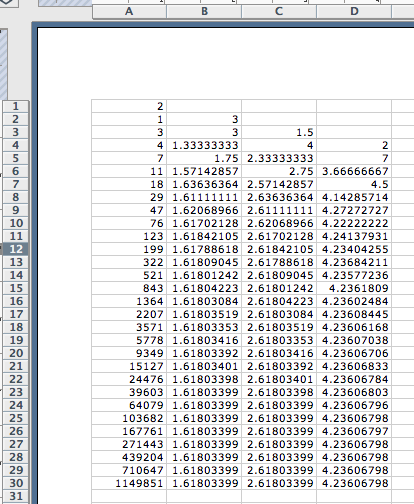
Wow! Our limit still approaches our g value, or our golden ratio and various powers of this number.
Let's look at one more thing. What if our first term is zero? Let's do f(0) = 0 and f(1) = 2.
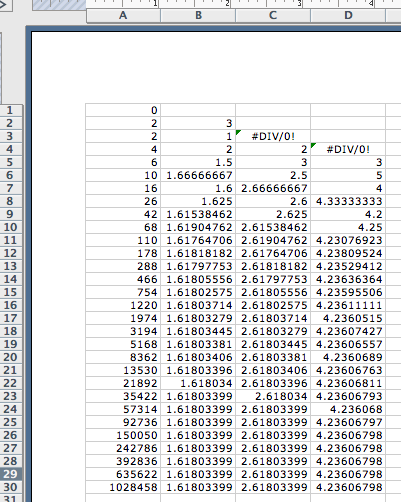
The only difference in these values is that the first values of some of our ratios do not exist as you cannot divide by zero. However, once we get down to the next value and continue on, our numbers converge to the golden ratio and various powers of the golden ratio again.
Thus, no matter what value we use for our first values, the limit will always approach the value of g, or the golden ratio, and various powers of this ratio, which is the same limit of the Fibonacci sequence.